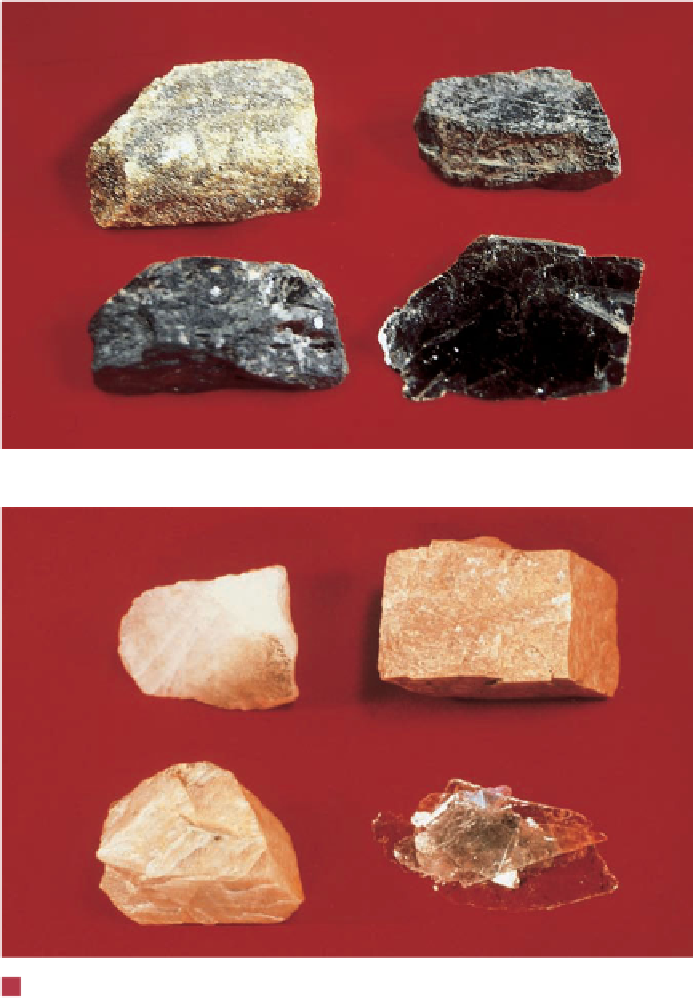Geology Reference
In-Depth Information
luster. Among the several types of
nonmetallic luster are glassy or vit-
reous (as in quartz), dull or earthy,
waxy, greasy, and brilliant (as in dia-
mond) (Figure 3.1a).
Beginning geology students are
distressed by the fact that the color
of some minerals varies considerably,
making the most obvious physical
property of little use for mineral iden-
tification. In any case, we can make
some helpful generalizations about
color. Ferromagnesian silicates are
typically black, brown, or dark green,
although olivine is olive green (Figure
3.13a). Nonferromagnesian silicates,
on the other hand, vary consider-
ably in color, but are rarely very dark.
White, cream, colorless, and shades of
pink and pale green are more typical
(Figure 3.13b).
Another helpful generalization is
that the color of minerals with a me-
tallic luster is more consistent than is
the color of nonmetallic minerals. For
example, galena is always lead-gray
(Figure 3.14b) and pyrite is invariably
brassy yellow. In contrast, quartz, a
nonmetallic mineral, may be colorless,
smoky brown to almost black, rose,
yellow-brown, milky white, blue, or
violet to purple (Figure 3.8a, b).
◗
Figure 3.13
Common Rock-Forming Silicate Minerals
Pyroxene
Olivine
Amphibole
Biotite
The ferromagnesian silicates.
a
Quartz
Potassium feldspar
As we noted, many mineral specimens
do not show the perfect crystal form
typical of that mineral species. Nev-
ertheless, some minerals do typically
occur as crystals (
Plagioclase feldspar
Muscovite
Figure 3.15a-d).
For example, 12-sided crystals of gar-
net are common, as are 6- and 12-sided
crystals of pyrite. Minerals that grow in cavities or are precip-
itated from circulating hot water (hydrothermal solutions) in
cracks and crevices in rocks also commonly occur as crystals
and, under ideal conditions, some minerals grow to incred-
ible sizes (Figure 3.15d).
Crystal form can be a useful characteristic for mineral
identifi cation, but a number of minerals have the same crys-
tal form. Pyrite (FeS
2
), galena (PbS), and halite (NaCl) all
occur as cubic crystals, but they can be easily identifi ed by
other properties such as color, luster, hardness, and density.
◗
The nonferromagnesian silicates.
b
OF MINERALS
Many physical properties of minerals are remarkably constant
for a given mineral species, but some, especially color, may vary.
Although professional geologists use sophisticated techniques
to study and identify minerals, most common minerals can be
identifi ed by using the physical properties described next.
Luster
(not to be confused with
color
) is the quality and
intensity of light refl ected from a mineral's surface. Geolo-
gists defi ne two basic types of luster:
metallic
, having the ap-
pearance of a metal, and
nonmetallic.
Notice that of the four
minerals shown in Figure 3.14, only galena has a metallic
Not all minerals possess
cleavage
, but those that do break,
or split, along a smooth plane or planes of weakness de-
termined by the strength of their chemical bonds. Cleavage
is characterized in terms of quality (perfect, good, poor),


Search WWH ::

Custom Search